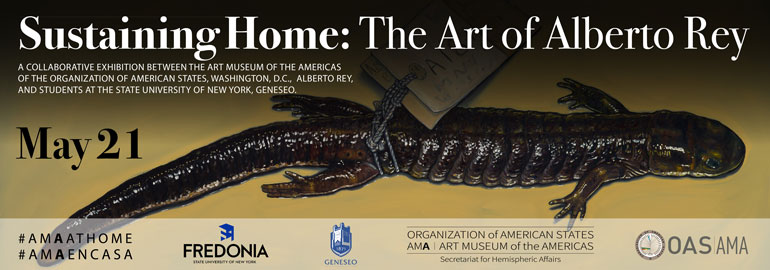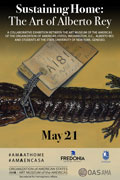
Mareasa Giudici is a Sophomore at SUNY Geneseo, working towards a Major in Art History and a Minor in Museum Studies. She presented a paper on the work she did for this exhibition at the Annual Art History Symposium at SUNY Geneseo. The experience of working with Alberto Rey has been inspiring for her and it has opened her eyes to the many ways in which art, politics and social issues intertwine. She is continuing her studies and career goals with a firm commitment to always make art and museums a significant part of her life.
On social media May 29, 2021
The Aesthetics of Death
by Mareasa Giudici
While every living organism dies eventually, familiarizing oneself with death can ensure that along with discomfort, remembrance can be found. This is what Cuban artist Alberto Rey displays in his Aesthetics of Death series. 2004 was a year of grief for Rey which inspired him to paint large steelhead trout as a gateway for managing his grief. The significant size of these paintings reflects the importance of the meaning they hold. Death is a universal experience, and when experienced firsthand, it can bring an understanding of the fragility of life. This series is meant to invoke strong feelings about the appreciation of life and the inevitability of death.
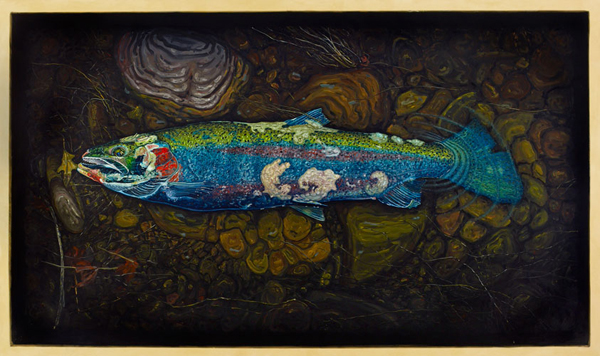
The Aesthetics of Death: Aesthetics of Death: VIII, 2006-2008, Oil on Plaster, 72 x 120”
Oftentimes, dead fish are something from which people tend to avert their eyes and attention. This is not the case with Rey’s Aesthetics of Death: VIII, which is an incredibly bold painting that compels the spectator to examine all of its vivid details. The size of the trout in this series is a nod to traditional historical paintings. However, Rey breaks this barrier by diverting the subject matter of the narratives of the historical genre and instead, he makes a contemporary expression of confrontation with death, which features dead and decaying fish. This brightly colored trout looks too colorful to belong to the waters of Western New York State but they have a purpose. These colors are a bold and paradoxical nod to the beauty of life. This series suggests what happens after death and allows each viewer to come up with their own interpretation of a potential afterlife.
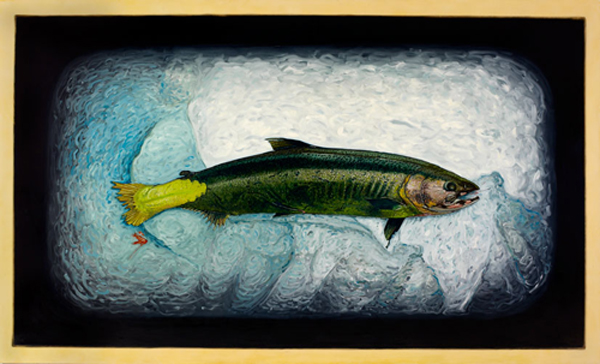
The Aesthetics of Death: Aesthetics of Death: VII, 2006-2008, Oil on Plaster, 72 x 120”
Every culture responds to death in a different way. In Rey’s Cuban culture, All Souls Day in the Catholic Calendar of Holy Days, is identified as El Día de los Muertos (The Day of the Dead). All Souls Day is a day of religious celebration that commemorates the life of those who have died. Rey’s family did not overly celebrate this holiday, yet this series is a personal homage to his own family members, lost during a period of recurring illness and death that marked Rey’s life. The events that accompanied this time of mourning and worry made him pause to contemplate and wonder about the frailty of life and it is that meditation that formed the basis for the Aesthetics of Death Series. Aesthetics of Death: VII portrays a trout just as he found it, on ice. The rotting flesh signifies the duality of life and death. In contrast to a brighter array of colors seen in other works, this duller color scheme represents the natural progression of death to decay.
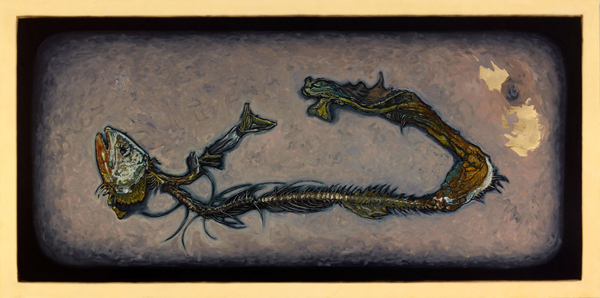
The Aesthetics of Death: Aesthetics of Death: VI, 2006-2008, Oil on Plaster, 48 x 96”
Alberto Rey’s personal losses were devastating and they included the passing of his sister and father-in-law a few months apart, and his wife’s struggle with cancer later that year. He was able to reconcile his grief and focus on the appreciation of life through his creation of works such as Aesthetics of Death: VI, which portrays a trout in an advanced stage of decomposition where it is further removed from life. The bleak background contrasts with the rotting trout to accentuate the after-effects of death. Although immersed in death, Rey’s series insists that a commonality that all living things share is that the transformation from life to death is natural.
For many, conversations about death and the afterlife is not a comfortable topic, and yet no living organism can escape this natural phenomenon. While no one knows definitively the answer to the question “what happens after death?” this series allows us to explore these options. Alberto Rey’s Aesthetics of Death series propels us to contemplate how we personally react to loss and allows us an opportunity to familiarize ourselves with what we believe occurs after life. Rey’s Aesthetics of Death Series portrays trout during their natural progression of decay while simultaneously reenforcing the beauty of life.

